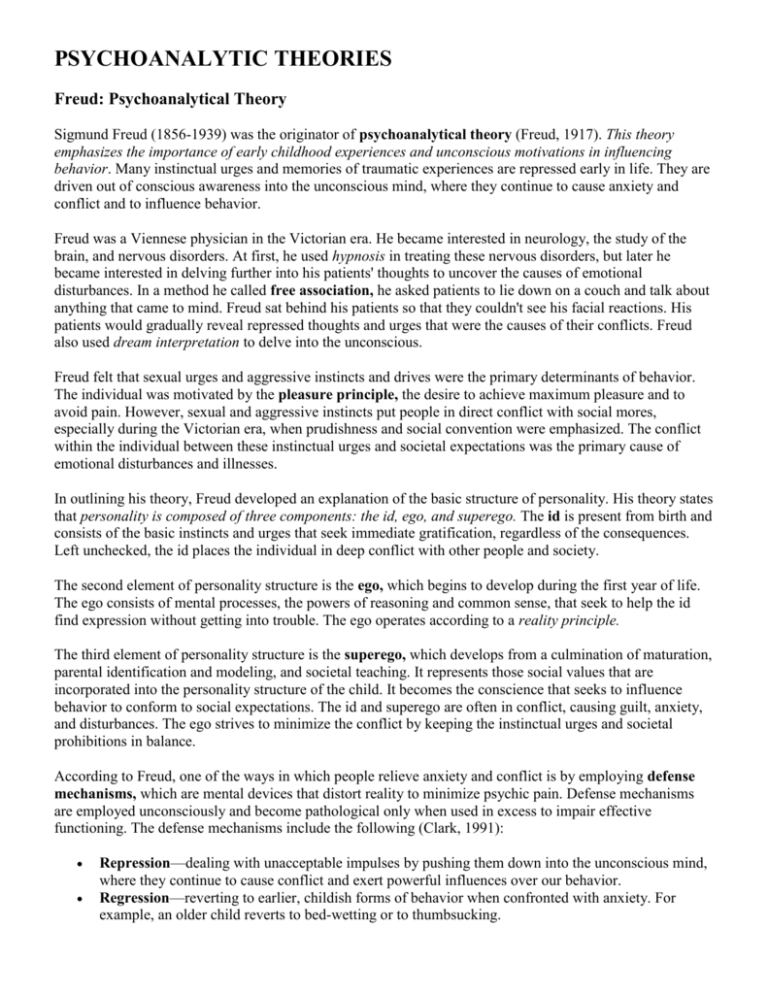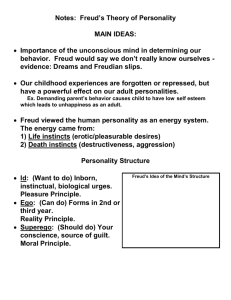
PSYCHOANALYTIC THEORIES
Freud: Psychoanalytical Theory
Sigmund Freud (1856-1939) was the originator of psychoanalytical theory (Freud, 1917). This theory
emphasizes the importance of early childhood experiences and unconscious motivations in influencing
behavior. Many instinctual urges and memories of traumatic experiences are repressed early in life. They are
driven out of conscious awareness into the unconscious mind, where they continue to cause anxiety and
conflict and to influence behavior.
Freud was a Viennese physician in the Victorian era. He became interested in neurology, the study of the
brain, and nervous disorders. At first, he used hypnosis in treating these nervous disorders, but later he
became interested in delving further into his patients' thoughts to uncover the causes of emotional
disturbances. In a method he called free association, he asked patients to lie down on a couch and talk about
anything that came to mind. Freud sat behind his patients so that they couldn't see his facial reactions. His
patients would gradually reveal repressed thoughts and urges that were the causes of their conflicts. Freud
also used dream interpretation to delve into the unconscious.
Freud felt that sexual urges and aggressive instincts and drives were the primary determinants of behavior.
The individual was motivated by the pleasure principle, the desire to achieve maximum pleasure and to
avoid pain. However, sexual and aggressive instincts put people in direct conflict with social mores,
especially during the Victorian era, when prudishness and social convention were emphasized. The conflict
within the individual between these instinctual urges and societal expectations was the primary cause of
emotional disturbances and illnesses.
In outlining his theory, Freud developed an explanation of the basic structure of personality. His theory states
that personality is composed of three components: the id, ego, and superego. The id is present from birth and
consists of the basic instincts and urges that seek immediate gratification, regardless of the consequences.
Left unchecked, the id places the individual in deep conflict with other people and society.
The second element of personality structure is the ego, which begins to develop during the first year of life.
The ego consists of mental processes, the powers of reasoning and common sense, that seek to help the id
find expression without getting into trouble. The ego operates according to a reality principle.
The third element of personality structure is the superego, which develops from a culmination of maturation,
parental identification and modeling, and societal teaching. It represents those social values that are
incorporated into the personality structure of the child. It becomes the conscience that seeks to influence
behavior to conform to social expectations. The id and superego are often in conflict, causing guilt, anxiety,
and disturbances. The ego strives to minimize the conflict by keeping the instinctual urges and societal
prohibitions in balance.
According to Freud, one of the ways in which people relieve anxiety and conflict is by employing defense
mechanisms, which are mental devices that distort reality to minimize psychic pain. Defense mechanisms
are employed unconsciously and become pathological only when used in excess to impair effective
functioning. The defense mechanisms include the following (Clark, 1991):
Repression—dealing with unacceptable impulses by pushing them down into the unconscious mind,
where they continue to cause conflict and exert powerful influences over our behavior.
Regression—reverting to earlier, childish forms of behavior when confronted with anxiety. For
example, an older child reverts to bed-wetting or to thumbsucking.
Sublimation—replacing distasteful, unacceptable behavior with behavior that is socially acceptable.
For example, a man filled with anger and hostility and aggression participates in competitive sports,
lest he explode into violence (Kohn, 1988).
Displacement—transferring strong emotions from a source of frustration and venting them on
another object or person who becomes the scapegoat. An example would be a child who becomes
angry at her parents and takes out her hostile feelings on a pet dog.
Reaction formation—acting completely opposite of the way that one feels to hide unacceptable
feelings or tendencies. A person might crusade against child sexual abuse (pedophilia) because he or
she has such tendencies.
Denial—protecting oneself from anxiety by refusing to acknowledge that a situation exists. One
example might be to refuse to acknowledge that a child is mentally retarded.
Rationalization—making up excuses for behavior that would otherwise be unacceptable.
Not only did Freud develop a theory of personality structure, but he outlined a psychosexual theory of
development as well. According to Freud, the center of sensual sensitivity, or erogenous zones, shifts from
one body zone to another as children mature. The stages of psychosexual development according to Freud
are as follows:
Oral stage—first year of life, during which the child's chief source of sensual gratification centers
around the mouth. The infant's chief source of pleasure and gratification is through sucking, chewing,
and biting. Such activity increases security and relieves tension.
Anal stage—ages 2 to 3, during which the child's principal source of greatest pleasure is through anal
activity. This is the age when the child becomes very interested in eliminative functions, toileting
activities, and training.
Phallic stage—ages 4 to 5, during which the center of pleasure shifts to the genitals as children
explore their bodies through self-manipulation.
Latency stage—age 6 to puberty, during which time the child represses sexual urges and devotes
time and energy to learning and physical and social activities. The source of pleasure shifts from self
to other persons as the child becomes interested in cultivating the friendship of others.
Genital stage—beginning with sexual maturation, after which the young person seeks sexual
stimulation and satisfaction from a member of the opposite sex. This stage continues through
adulthood.
Freud also taught that boys experience castration anxiety and that girls develop penis envy because of the
lack of a phallus. Freud said that penis envy in girls becomes a major source of what he termed women's
sense of inferiority. Also, during this period, boys develop an Oedipal complex and fall in love with their
mother, becoming jealous of their father as they compete for their mother's love and affection (Thomas,
1991). Gradually, they repress their incestuous feelings and begin to identify with their father during the next
stage of development. Meanwhile, during this period, girls develop an Electra complex and fall in love with
their father, becoming jealous of their mother as they compete for their father's love and affection. They also
blame their mother for the fact that they have no penis. They are ready for the next stage when they are able
to repress their incestuous feelings for their father and identify with their mother.
Freud said that if children receive too much or too little gratification at any given stage, they become fixated
at that stage, so that their psychosexual development is incomplete. Thus, if children receive too little oral
gratification during that stage, they may continue to try to find oral gratification later in life through
smoking, eating, kissing, drinking, or chewing. Children who become fixated at the latency stage seek to
repress sexual feelings and continue to identify with the same-sex parent, never moving on to make mature
heterosexual adjustments (Emde, 1992).








